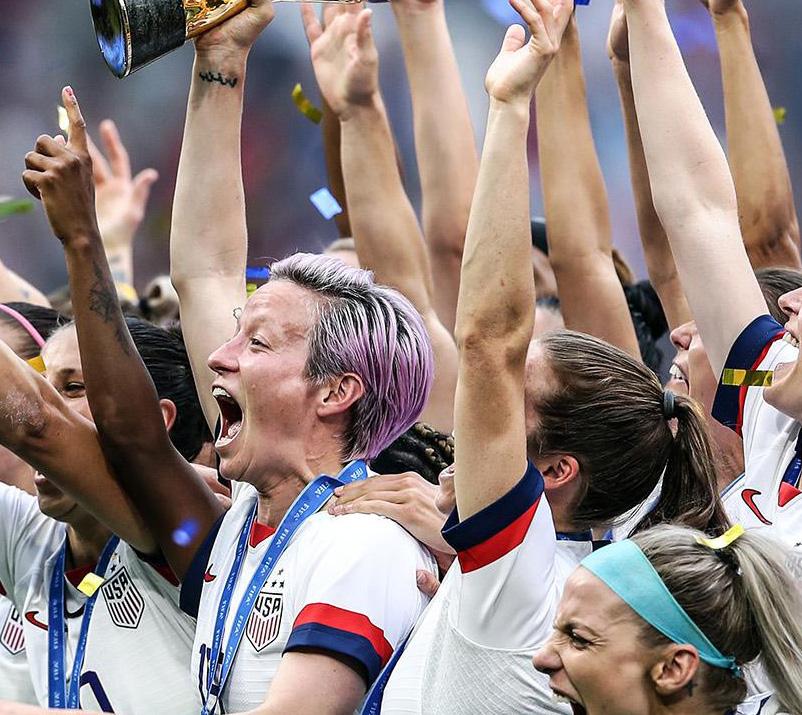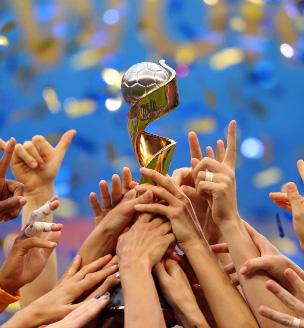
7 minute read
WORLD CUPS
Ten reasons the Women’s World Cup 2023 will be bigger than Qatar 2022
By Christina Thakor-Rankin
Women’s sport is on the rise. A recent Neilson Report indicates that up to 84% of all sports fans (51% male and 49% female) are interested in watching women’s sport. In countries like the UK, US, New Zealand, Australia, Spain, Germany, Italy, and France - around 66% of the population is interested in at least one women’s sport. Further research indicates that when it comes to the most recognisable female team sports athletes football players appear in almost every national list - in France, Germany, and Italy the top three most recognizable female athletes are footballers, and in the US the top two.
2. Women’s football (soccer) is the fastest growing sport on the planet - bar none. Recent reports by Pitcher and WGP Global show the exponential rise in popularity of women’s football both in terms of players and viewers. The most compelling figures are FIFA’s own. Audience numbers for the last Women’s World Cup in 2019 broke the 1 billion mark - exceeding all previous records and expectations. A closer look at the numbers indicates that this was not regional but global. Audiences figures in Africa and the Middle East doubled from 12 to 24 million compared to the previous WWC in 2015, the rise in other parts of the worlds was even bigger with Europe seeing an increase in audience number of 136% and Latin America a staggering 560%. The overall growth in audience from 2015 to 2019 was 65%.
The largest increase in viewers was Asia with coverage of live matches increasing in every territory compared to the previous event in 2015. A point of interest for sportsbook operators who link viewer numbers with betting activity is that the 10 most watched games in 2019 involved the national teams of countries where betting is now a regulated activity. The final between US and The Netherlands pulled in a live global audience of just over 82 million. This may pale in comparison to audience figures for the men’s equivalent in 2018 but compare it to other events such as an average audience of 102 million for the Superbowl, and the rise in popularity of women’s football becomes increasingly hard to ignore.
3. Generation Z. ‘Post-millennials’, ‘snowflakes’, ‘zoomers’ - call them what you will, this generation is here, and already taking on the world. Tech savvy, globally connected, socially responsible and the most ethnically and racially diverse generation ever, this group has the sheer scale of numbers to make things happen. This is the protest generation, from climate change to racial

and social injustice and inequality. They do not believe in labels or stereotypes. they do believe in equality and being defined not by who they are - but what they can do.
4. Not just for boys. The impact of Generation Z values of equality is starting to make their mark. As they start to come of age, they are using their voice as a means of dismantling old and established stereotypes. The world has more females leaders than ever before, and women making their mark in other areas of life too. From Kamala-Harris becoming the first woman mixed-race Vice-President to the recent UAE space agency currently led by a woman, and the team responsible for their mission to Mars being 80% female, woman arestarting to take on the boys in almost every aspect of life. This includes things like esports, which now has professional female teams and e-athletes and where the gender split is estimated to be around 50/50, and of course sports generally as witnessed by the increase in female viewers and more female pundits for mainstream sports broadcasts and programmes. A landmark crossover moment was EA sports putting Alex Morgan alongside Lionel Messi on the cover of its US version of FIFA 2016.
5. Female sports bettors are on the rise. Given the growing popularity of women’s sports, the growing numbers of Generation Z and their growth of slogans and initiatives like ‘This girl can’ it is perhaps no surprise that this trend is starting to make itself evident in sports-betting. What is perhaps surprising is the suggested number of female bettors compared to their male counterparts. A study last year suggested that the spilt between male and female sports-bettors could be as high as 43% female to 57% male. Others predict female sports bettors to be in the more conservation region of 20 to 30% compared to their male counterparts. The numbers have been met with a degree of incredulity from some quarters but is it really that surprising given that the trajectory of regulated sports betting in the US is on a par with the growing popularity of women and sports and



31st January 2022


Generation Z. The increase in female led sports blogs, podcasts, pundits and tipping sites surely speaks for itself. Most compelling of all is the fact that one US operator actually conducted some demographic analysis and concluded that typically female sports-bettors are more successful with higher ROI than their male equivalents. Just the fact that a major player has even looked into this suggests that female sports-bettors may after all be ‘a thing’.
6. New role models. One of the most interesting post on Instagram this year by #worthfeed showed a sideby-side comparison between a near nude picture of Kendall Jenner and Alyssa Carson who at 19 just became NASA’s youngest ever astronaut. The new generation is starting to re-define the term role model. Increasingly today’s role model is about relatability and achievement – ‘if they can do it so can I’ - and no longer just about looks or money.
7. Football as a platform for equality and human rights. The game is increasingly becoming a springboard for quality in sports. The Norwegians became the first country to pay their male and female national teams the same pay. More recently Canada has seen a conversation about merchandise and the lack of it for the women’s game when compared to the men. Football is also becoming a platform for a conversation about human rights with protests from national teams and sponsors and the arrest this week of journalists in Qatar reporting on human rights abuses and the plight and deaths of migrant labourers building the stadiums for the world cup. 3 things women could do as part of its move towards addressing women’s rights (the other two were driving and going to the cinema). It has made women’s soccer a key part of its Vision 2030strategy and earlier this year launched the first Saudi women’s football league. Iran recently faced a national football scandal where some of the players in the women’s side were accused of being men. The explanation was that they were not men they were trans-gender. This is unprecedented. Two hard-line Islamic nations using women’s football as a vehicle for modernisation and exploring otherwise taboo subjects.
9. Qatar 2022 - ‘worst’ world cup ever? The arrest of 2 journalists reporting on the World Cup is only the latest in a long line of reasons why folks are not happy. From speculation about the treatment of fans (in particular women), impact of the heat, rumours of corruption, timing of the event at the end of the year and the rising tide of protests about violation of human rights - Qatar 2022 has been shrouded in negativity since the start. If Qatar does end up being as bad as some believe it might, FIFA will be under the spotlight and have to do everything it can with the next event to win back trust and confidence and limit the damage of Qatar 2022. Cue the Women’s World Cup 2023.
10. Women’s World Cup 2023. The WWC 2023 willbring together women of every creed, colour, race, and religion in the spirit of togetherness embodying the values, beliefs, and aspirations of a new generation across the world, and an anthem for gender equality and a platform for social and cultural change the world over. This truly would take the sport from beautiful game to Beyond Greatness .








